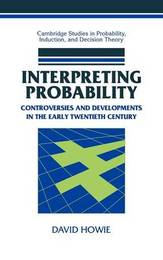
|
Interpreting Probability: Controversies and Developments in the Early Twentieth Century
Hardback
Main Details
Description
The term probability can be used in two main senses. In the frequency interpretation it is a limiting ratio in a sequence of repeatable events. In the Bayesian view, probability is a mental construct representing uncertainty. This book is about these two types of probability and investigates how, despite being adopted by scientists and statisticians in the eighteenth and nineteenth centuries, Bayesianism was discredited as a theory of scientific inference during the 1920s and 1930s. Through the examination of a dispute between two British scientists, the author argues that a choice between the two interpretations is not forced by pure logic or the mathematics of the situation, but depends on the experiences and aims of the individuals involved. The book should be of interest to students and scientists interested in statistics and probability theories and to general readers with an interest in the history, sociology and philosophy of science.
Reviews"...this is a timely and valuable contribution to our knowledge o the period and its great figures. There is a wealth of incidental, but always relevant and often fascinating, historical detail. Another distinctive feature of his book is that, thought it concerns a highly technical subject matter, his own discussion is anything but technical in any overtly formal sense: in fact, there are hardly any formulas in the book. Yet he succeeds in conveying, in words, the technical ideas both precisely and clearly, Its thoroughness, combined with an assured informality and lightness of touch, make the book an enlightening and entertaining read." -Notre Dame Philosophical Reviews 02/02/2003 "A very valuable reference for researchers and general readers in probability, statistics, and the history and philosophy of science. Recommended." Choice
|